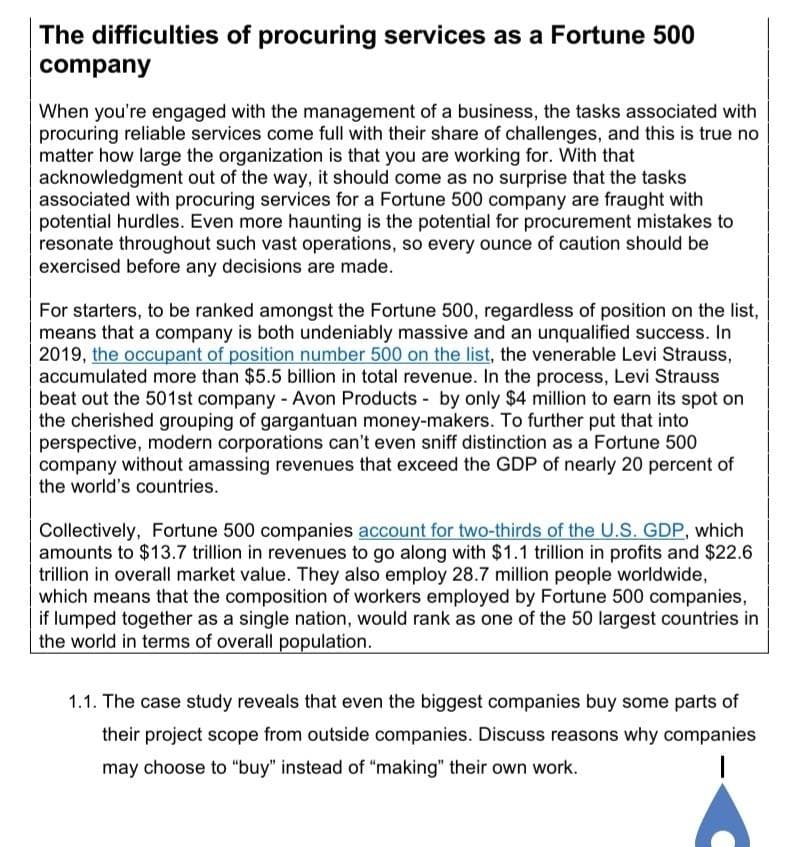1.1. The case study reveals that even the biggest companies buy some parts of their project scope from outside companies. Discuss reasons why companies may choose to "buy" instead of "making" their own work.
1.1. The case study reveals that even the biggest companies buy some parts of their project scope from outside companies. Discuss reasons why companies may choose to "buy" instead of "making" their own work.
Practical Management Science
6th Edition
ISBN:9781337406659
Author:WINSTON, Wayne L.
Publisher:WINSTON, Wayne L.
Chapter2: Introduction To Spreadsheet Modeling
Section: Chapter Questions
Problem 20P: Julie James is opening a lemonade stand. She believes the fixed cost per week of running the stand...
Related questions
Question
Question attached

Transcribed Image Text:The difficulties of procuring services as a Fortune 500
company
When you're engaged with the management of a business, the tasks associated with
procuring reliable services come full with their share of challenges, and this is true no
matter how large the organization is that you are working for. With that
acknowledgment out of the way, it should come as no surprise that the tasks
associated with procuring services for a Fortune 500 company are fraught with
potential hurdles. Even more haunting is the potential for procurement mistakes to
resonate throughout such vast operations, so every ounce of caution should be
exercised before any decisions are made.
For starters, to be ranked amongst the Fortune 500, regardless of position on the list,
means that a company is both undeniably massive and an unqualified success. In
2019, the occupant of position number 500 on the list, the venerable Levi Strauss,
accumulated more than $5.5 billion in total revenue. In the process, Levi Strauss
beat out the 501st company - Avon Products by only $4 million to earn its spot on
the cherished grouping of gargantuan money-makers. To further put that into
perspective, modern corporations can't even sniff distinction as a Fortune 500
company without amassing revenues that exceed the GDP of nearly 20 percent of
the world's countries.
Collectively, Fortune 500 companies account for two-thirds of the U.S. GDP, which
amounts to $13.7 trillion in revenues to go along with $1.1 trillion in profits and $22.6
trillion in overall market value. They also employ 28.7 million people worldwide,
which means that the composition of workers employed by Fortune 500 companies,
if lumped together as a single nation, would rank as one of the 50 largest countries in
the world in terms of overall population.
1.1. The case study reveals that even the biggest companies buy some parts of
their project scope from outside companies. Discuss reasons why companies
may choose to "buy" instead of "making" their own work.
Expert Solution
This question has been solved!
Explore an expertly crafted, step-by-step solution for a thorough understanding of key concepts.
Step by step
Solved in 2 steps

Recommended textbooks for you

Practical Management Science
Operations Management
ISBN:
9781337406659
Author:
WINSTON, Wayne L.
Publisher:
Cengage,

Operations Management
Operations Management
ISBN:
9781259667473
Author:
William J Stevenson
Publisher:
McGraw-Hill Education

Operations and Supply Chain Management (Mcgraw-hi…
Operations Management
ISBN:
9781259666100
Author:
F. Robert Jacobs, Richard B Chase
Publisher:
McGraw-Hill Education

Practical Management Science
Operations Management
ISBN:
9781337406659
Author:
WINSTON, Wayne L.
Publisher:
Cengage,

Operations Management
Operations Management
ISBN:
9781259667473
Author:
William J Stevenson
Publisher:
McGraw-Hill Education

Operations and Supply Chain Management (Mcgraw-hi…
Operations Management
ISBN:
9781259666100
Author:
F. Robert Jacobs, Richard B Chase
Publisher:
McGraw-Hill Education


Purchasing and Supply Chain Management
Operations Management
ISBN:
9781285869681
Author:
Robert M. Monczka, Robert B. Handfield, Larry C. Giunipero, James L. Patterson
Publisher:
Cengage Learning

Production and Operations Analysis, Seventh Editi…
Operations Management
ISBN:
9781478623069
Author:
Steven Nahmias, Tava Lennon Olsen
Publisher:
Waveland Press, Inc.